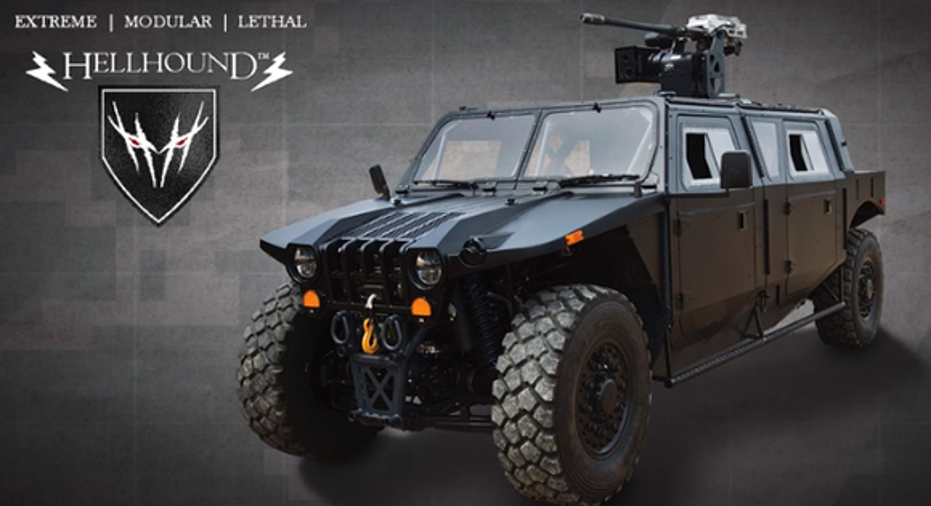Northrop Grumman Invents a Laser Tank

Look out, Boeing . There's a new laser tank in town.
Northrop's new Hellhound LRV packs a 30 mm cannon today -- and maybe a 30 kW laser cannon tomorrow. Image source: Northrup GrummanYouTube still.
For more than six years now -- some might argue for more than a decade -- U.S. defense contractors including Boeing and Raytheon , Lockheed Martin , and Kratos Defense have been hard at work designing working laser weapons for the U.S. military.
In 2009, Boeing announced its entry into the competition, a "Heavy Expanded Mobility Tactical Truck" capable of mounting a 10-kilowatt laser.
Raytheon has an even more powerful laser, the 25-kilowatt Ground Based Air Defense Directed Energy On-the-Move Future Naval Capabilities, which it totes around in the back of a Humvee.
Kratos built a 33-kilowatt Laser Weapon System for the Navy -- but it's so big it requires a warship to carry it.
And Lockheed Martin is working on a 60-kilowattHigh Energy Laser Mobile Demonstrator for the Army. While not all the way up to 60 yet, it can already push out 30 kW... and to devastating effect:
LOCKHEED'S LASER GUN: 1; TRUCK: 0. IMAGE SOURCE:LOCKHEED MARTIN.
*Batteries not includedAnd yet, there's one tiny detail that may get in the way of any of these laser weapons performing as promised: They all need a lot of power to operate.
As website BreakingDefense explains, translating electric output into laser output is not a very efficient process. It takes about three units of power generated to produce each incremental kilowatt of laser emitted. As a result, the 10 kilowatts of "exportable" electricity generated by an Oshkosh JLTV probably won't be enough to power an effective laser weapon system on its own. For that matter, a 30-ton Bradley APC only puts out 20 kilowatts of exportable electric power -- which, again, isn't enough to power the kinds of laser weapons the military wants.
Fact is, you need about 90 kW of electric generation to power even a 30-kilowatt laser -- and that's if the vehicle is sitting still. Run the A/C or leave the radio on (or maneuver your vehicle in the middle of a firefight), and you need a whole lot more juice to power your laser.
This is where Northrop Grumman comes in.
Last month, Northrop introduced a new prototype light reconnaissance vehicle that it calls the Hellhound. Small enough to fit in the cargo hold of a CH-47 Chinook, Hellhound nonetheless packs a powerful 120 kW Jenoptik integrated starter generator, capable of "exporting" 100 kilowatts of electricity over and above what's needed to power the vehicle itself. That's enough juice to power a small field hospital or a military command center -- or, should one be so inclined, a 30-kilowatt laser cannon.
What it means to investorsAlthough Northrop Grumman has a pretty wide-ranging laser research and development department of its own, to date the company has played primarily a supporting role in developing other companies' marquee laser weapons projects. Northrop's development of the Hellhound promises to continue that trend.
By offering a vehicle capable of mounting other companies' various laser weapons and -- crucially -- generating the power those weapons will need to operate, Northrop appears to be positioning itself to partner with any number of its defense contracting "rivals" as they win contracts to produce actual laser weapons. Granted, it's not as "sexy" a business as building actual laser cannons -- but it may be a smart business strategy nonetheless.
Source: Northrop GrummanYouTube still.
The article Northrop Grumman Invents a Laser Tank originally appeared on Fool.com.
Rich Smithowns shares of Raytheon. You can find him onMotley Fool CAPS, publicly pontificating under the handleTMFDitty, where he's currently ranked No. 318 out of more than 75,000 rated members.The Motley Fool has no position in any of the stocks mentioned. Try any of our Foolish newsletter services free for 30 days. We Fools may not all hold the same opinions, but we all believe that considering a diverse range of insights makes us better investors. The Motley Fool has a disclosure policy.
Copyright 1995 - 2015 The Motley Fool, LLC. All rights reserved. The Motley Fool has a disclosure policy.



















